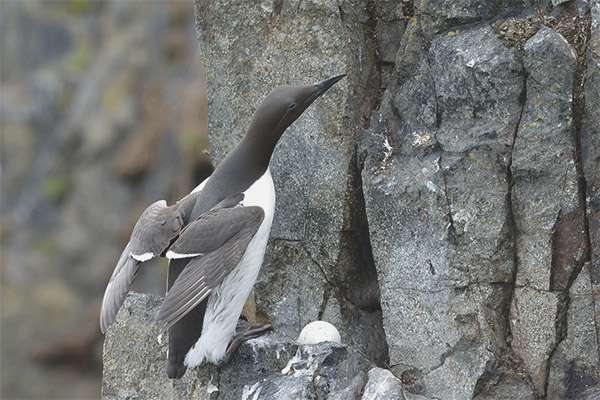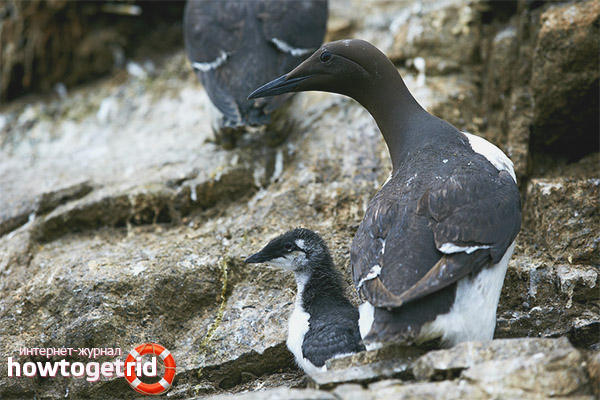The content of the article
A permanent resident of the far north of the Kurre belongs to the family of all-law. These seabirds spend almost all their life in cold waters, getting to land only during the nesting period. Kaira is widespread in the northern hemisphere. During the reproduction and laying of eggs the murre is selected on the rocky shores. They form a fairly large number of flocks, which are often called bird market. The size of the murre is similar to a duck, but it has a completely different color.
Appearance of the bird Murre
Today, the murre is the largest representative of the whole family. In nature, there are two birds of this species - thin-billed and thick-billed murre. The kaira is somewhat like a penguin, it has the same black back and white belly. The neck is also black in color, but in winter the outfit in the neck becomes white.The size of the bird is about 40-45 cm, weight usually does not exceed one kilogram, and the wingspan is about 70 cm. Regardless of the season, the beak constantly remains black with a thin white stripe at the base. Beak murre very strong, thick, sharp and curved down. The body of the thick-billed murre is rather wide at the top and tapers down. The tail is usually rounded and raised, like a real penguin.
The thick-billed and thin-billed murres are very similar in appearance, the main distinguishing sign is the size and thickness of the beak. In addition, the finely billed murre has a shorter neck, it does not have gray flecks on the sides of the body, its color is more black. In addition, only thin-billed representatives of the species have a characteristic white strip in the corners of the mouth. As a rule, the female does not differ from the male kayra, only in size. The thick billed murre is generally a bit more massive. Despite the fact that both representatives of the species are quite similar to each other, the murre almost never intersect, preferring to choose a partner only from among the representatives of their own subspecies.
Habitat of a northern resident
As it was noted, the Kurre needs the northern seas and oceans, in which there is a lot of fish. The bird feels great even at the most extreme low temperatures. However, for normal vital activity the kaira needs food and non-freezing water. The harsher the winter is in the north, the nearer to the south during the wintering period is the kaira. The Kaira habitat extends from the shores of the North Atlantic to the north of the Pacific Ocean and the shores of the Arctic Ocean. In the south side, the bird settles to Portugal, the British Isles, the Korean Peninsula, as well as to the northern part of Japan and California. The thick-billed kayri prefer more arctic waters.
Lifestyle
Curries live in large colonies, they are not afraid of people - they can allow scientists quite close. The average life expectancy is about 30 years, although the scientists recorded a case of a rather long life of the murre - almost 43 years. In large flocks, the thick-billed murreus gets on well with the subtly-beak representatives of the species, eagles, maevka and other birds. The main diet of the muspah is fish of all sorts and sizes. In winter, when fish are getting smaller, the Kaira gladly regales on crustaceans, mollusks, worms, and other marine invertebrates. Fish, as a rule, are eaten immediately after the catch - right under the water. On land, prey is taken out very rarely, only for feeding chicks.
Breeding Murre
Kayri arrive for nesting at the end of April and at the beginning of May, choosing rocky shores for hatching.As such, the birds do not have a nest - the laying takes place directly in a recess of stones. Kayry lay one pear-shaped egg. This form protects the egg from falling, because it has no other points of contact. An elongated and pointed egg can whirl around its axis, but is unlikely to fall down the cliffs. The color of an egg can be white, gray, and even blue, each laying has its own pattern of inclusions and a shade of shell. Each egg is unique and parents easily recognize it among the rest of the offspring.
Heron nesting becomes permanent for her. Upon reaching two years of age, puberty begins, males and females pick up a mate. In relationship, the monkes are monogamous - they remain loyal to their partner for life. Throughout life, nest in one place, arriving there again and again every year. The duration of egg incubation is about a month. If the chick or the egg at some stage dies, the female can postpone another clutch, up to three times per season. A month after the chick hatches, the parents stimulate the babies to descend into the water, they teach them to fish and escape from enemies.Together with their parents, the murreys are sent for the first wintering.
Interesting facts about the race
Birds of this species are not shy, which allows them to more closely observe their behavior and draw interesting conclusions.
- During the nesting period and on land, the Murre are fairly silent - they are busy. But at another time, among the large colonies, the murre are very noisy and grumpy. Conflicts develop almost constantly. As a rule, males find out the relationship between themselves for owning a more attractive female. The fair sex is not far behind - they find out the relationship and fight for the best place to build a nest.
- Kaira are very caring parents who, from the first days of their life, feed them small fish and mollusks. Feeding stops one day before the babies have to go down into the water. So Murres stimulate chicks to hunt.
Sometimes the Murre can do without even the shore, during migration, the birds drift without any problems on the ice floes, sinking into the water only to find food for themselves. - Under the water, the rifle has no equal, it swims quickly, it is perfectly controlled by its wings, tail and legs, it can instantly change the trajectory of movement. Even the most nimble little fish will not leave this predator.
- The male Kyra has a wonderful attitude to his lady - he helps her to hatch eggs, substitutes for her when the “mommy” goes to feed, protects her partner and the chick.
- Even in the "womb", when the baby is in the egg, the parents gently knock on the shell. In this way, they establish a connection, show their love to the kid, give information about the outside world.
- Some birds take care of the offspring of their neighbors. Kayry unfortunately not famous for this. If both parents are absent from the egg, no one will protect him from falling off a cliff.
In their natural environment, Cyrus has practically no enemies - due to the harsh climate. Most of the lost eggs fall on clutter when adults find out between themselves and crush freshly laid eggs. Often birds can fall into fishing nets or be crushed by ice floes. Often the eggs fall due to the fact that parents have chosen not quite a good place for laying. But these small and isolated incidents do not affect the growth of the population of the thick-billed and thin-billed murre. Among the predators that are dangerous to chicks, there may be large species of gulls, arctic fox, raven, and polar owl.For adult individuals, such enemies are not terrible, but they can encroach on offspring.
Today, the Kaira population numbers over a million pairs of individuals, which makes the bird one of the main links of the common ecosystem of the polar pole. Kaira is the largest representative of the Arctic spaces. People in every way protect the bird in the territories of nature reserves in which the kaira winters.
Video: Kaira (Uria)




 3 votes, on average: 4,33 out of 5
3 votes, on average: 4,33 out of 5







To send